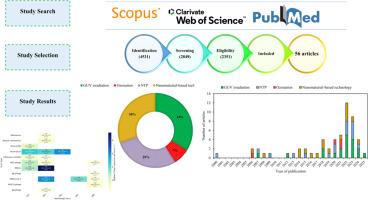缓解空气传播呼吸道病毒的新兴技术:系统综述
IF 7.6
1区 工程技术
Q1 CONSTRUCTION & BUILDING TECHNOLOGY
引用次数: 0
摘要
已经开发了多种技术来灭活建筑环境中的空气传播病毒,但它们的相对有效性和实际挑战尚未得到全面比较。这篇系统的综述评估了这些技术在建筑环境中的有效性、操作考虑和现实世界的适用性。我们采用PRISMA方法和目标关键词来识别发表在同行评议期刊上的相关研究。我们从符合我们的目标和纳入标准的研究中提取了与几种方法应用有关的数据和信息,包括杀菌紫外线(GUV)照射、臭氧化、非热等离子体(NTP)和基于纳米材料的技术。在2329篇潜在文章中,56篇研究被纳入。在大多数情况下,GUV照射使空气传播的病毒减少量超过1 log10(90%),其变化取决于GUV波长、剂量和实验条件。222 nm GUV对空气中病毒的抑制作用高于254 nm GUV (p = 0.075),表明222 nm GUV的效果更佳。呼吸道病毒比它们的替代噬菌体更容易被GUV灭活(p = 2.97 × 10⁻26)。臭氧在较高的相对湿度下最有效,在1.7 ppm下80分钟内可将流感病毒减少4 log10(99.99%)。NTP实现了1 - 6.5 log10的病毒减少量,暴露时间越长,病毒减少量越大。基于纳米材料的方法实现了0.34至6 log10之间的病毒灭活,在甲型H1N1流感中观察到的降幅最大。所有经过评估的技术都已证明能够在实验室条件下灭活空气传播的病毒;然而,它们的有效性因操作和实验参数以及病毒特性而异。因此,广泛的认可和标准化的指导仍然有限,由于异质的性能,安全的考虑,和缺乏严格的现实世界的研究。本文章由计算机程序翻译,如有差异,请以英文原文为准。

Emerging technologies for airborne respiratory virus mitigation: A systematic review
Multiples technologies have been developed to inactivate airborne viruses in built environments, yet their relative effectiveness and practical challenges have not been comprehensively compared. This systematic review assesses the efficacy, operational considerations, and real-world applicability of these technologies in built environments. We employed PRISMA approach along with targeted keywords to identify relevant studies published in peer-reviewed journals. We extracted data and information pertaining to the application of several methods, including germicidal ultraviolet (GUV) irradiation, ozonation, non-thermal plasma (NTP), and nanomaterial-based technologies from studies that met our objectives and inclusion criteria. Out of 2329 potential articles, 56 studies were included. GUV irradiation achieved airborne virus reductions exceeding 1-log10 (90 %) in most cases, with variability depending on GUV wavelength, dose and experimental condition. Airborne virus reductions were higher with 222-nm GUV than with 254-nm GUV (p = 0.075), indicating a trend toward greater efficacy at 222 nm. Respiratory viruses exhibited significantly greater susceptibility to GUV inactivation than their surrogate bacteriophages (p = 2.97 × 10⁻⁶). Ozone was most effective at higher relative humidity, achieving up to a 4-log10 (99.99 %) reduction for influenza virus at 1.7 ppm over 80 min. NTP achieved virus reductions ranging from 1 to 6.5-log10, with greater reductions observed at longer exposure times. Nanomaterial-based methods achieved virus inactivation between 0.34 to 6 log10, with the highest reductions observed for influenza A (H1N1). All evaluated technologies have demonstrated the ability to inactivate airborne viruses under laboratory conditions; however, their effectiveness varies with operational and experimental parameters as well as virus characteristics. Consequently, broad endorsement and standardized guidance remain limited, owing to heterogeneous performance, safety considerations, and a paucity of rigorous real-world studies.
求助全文
通过发布文献求助,成功后即可免费获取论文全文。
去求助
来源期刊

Building and Environment
工程技术-工程:环境
CiteScore
12.50
自引率
23.00%
发文量
1130
审稿时长
27 days
期刊介绍:
Building and Environment, an international journal, is dedicated to publishing original research papers, comprehensive review articles, editorials, and short communications in the fields of building science, urban physics, and human interaction with the indoor and outdoor built environment. The journal emphasizes innovative technologies and knowledge verified through measurement and analysis. It covers environmental performance across various spatial scales, from cities and communities to buildings and systems, fostering collaborative, multi-disciplinary research with broader significance.
 求助内容:
求助内容: 应助结果提醒方式:
应助结果提醒方式:


